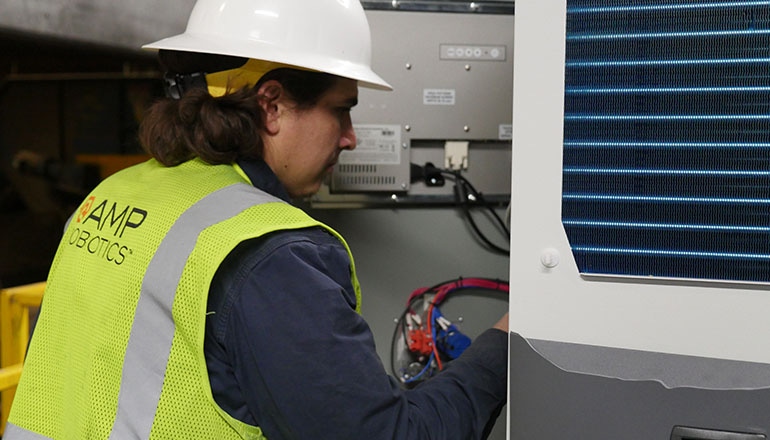AMP Robotics Vice President of Operations Robb Espinosa explains how robotics and artificial intelligence can help improve overall safety in the workplace.

Safety is top of mind for the waste and recycling industry, which has been listed on the most dangerous jobs list for years. Those in the industry are constantly seeking new ways to boost safety, and advancements in technology have played a large role in improving both safety and operations.
Two growing technologies, robotics and artificial intelligence (AI), have been entering the industry at a more rapid pace. And one of the companies ensuring that recycling facilities across the nation are installing and operating these technologies in a safe manner is Denver-based AMP Robotics.
AMP is committed to its products, customers, the industry and the environment, ensuring that recycling is a more efficient and safer operation for all parties.
Waste360 recently sat down with AMP Robotics Vice President of Operations Robb Espinosa to discuss how robotics and AI can help improve overall safety in the workplace and how the technologies can replace some of the more dangerous jobs, like sorting, in the recycling field.
Waste360: What safety testing does AMP conduct while creating its robotics?
Robb Espinosa: We take safety very serious here at AMP, and we follow the ANSI [American National Standards Institute] RA standards as well as the ANSI MRF [materials recovery facility] manufacturing standards. We have a couple people at AMP, including myself, who participate in the subcommittee for the ANSI standards. That has been a newly formed group specific to robotics and how they relate to the standards. We expect there to be a big review in February 2020 and then a follow-up in June.
Regarding safety and our robotics, we have guarding around the robots to keep people from entering the cell with the robot itself or the conveyor near the robot that’s moving. Our robots also have interlocks, and the biggest circuit is our safety chain that prevents multiple things from happening, such as opening the door and entering the cell with the robot. You can’t bypass our safety systems unless you physically deactivate a safety device with a tool or something with willful intentions.
All of these safety measures ensure the robots coming out of our plants and into the industry are safe and that the employees are safe as well.
Waste360: As robotics become smarter over time, what steps is AMP taking to ensure that they are running both safely and efficiently?
Robb Espinosa: Anytime we make a change, it has a big review. If we make a physical change to the cell or design, we have to comply with engineering standards that require us to do a risk assessment. If we do a one-off thing or a custom change, those also have to be reviewed.
Every unit that we put out into the market is tested in full operation as it would run in a facility. A minimum of 24-hour testing in full operation is required before systems are even shipped, and that helps ensure that all safety devices are working prior to leaving AMP’s facility.
Waste360: How can robotics help with some of the more dangerous jobs in the industry such as sorting?
Robb Espinosa: A robot is not going to get hurt or stuck by a needle, and we’ve seen needles in our suction cups. Robots also don’t need to go to the clinic and take medication to get better or wear gloves and PPE [personal protective equipment].
Robotics help keep people out of the way of some hazards, and it’s just safer to have a machine, specifically a robot, sorting garbage than a human being.
Waste360: What training do employees receive to ensure they are safe while working around robotics?
Robb Espinosa: Our employees go through extensive safety training to work with robots and know what the perimeters are almost to a fault. In addition to our safety training and guidelines that we use in our design, testing, assembly, QA/QC [quality assurance/quality control], loading, installation and service, we follow our customers’ safety procedures and training. AMP has their own requirements of PPE regardless of what a site may have, but if a site requires additional measures, we will comply by that as well.
All of our customers’ employees receive extensive training on how to maintain a robot. We have a written manual that’s reviewed with our customers at the time of installation. It’s part of our process and one of the first things we do to ensure employees are properly trained on the safety maintenance and operation of the robot.
Waste360: What are some of the ways that robotics and AI can help improve overall safety in the workplace?
Robb Espinosa: Robotics really can take the dangers out of sorting something that may be dangerous in the stream, and AI can be used to identify some of those hazardous that might be in the stream. We’re working on that capability right now, and, while it’s not completely developed yet, we want to be able to show if a customer is seeing a high percentage of sharps in the stream, for example.
Waste360: What safety best practices can you share for others in the industry to follow?
Robb Espinosa: There are a lot, but a couple stand out to me. If you’re on the ground at a MRF, your head needs to be on a swivel paying attention to your surroundings. You should also make sure those who have been at the company for a while are refreshed and reminded about safety procedures so they can lead a self-policing environment where people are looking out for themselves and others. Lastly, ignorance and complacency are the leading factors to most incidents or accidents, so take the time to make sure employees who are new to an environment, tool or process are trained properly and aware of what they’re doing.
About the Author(s)
You May Also Like




